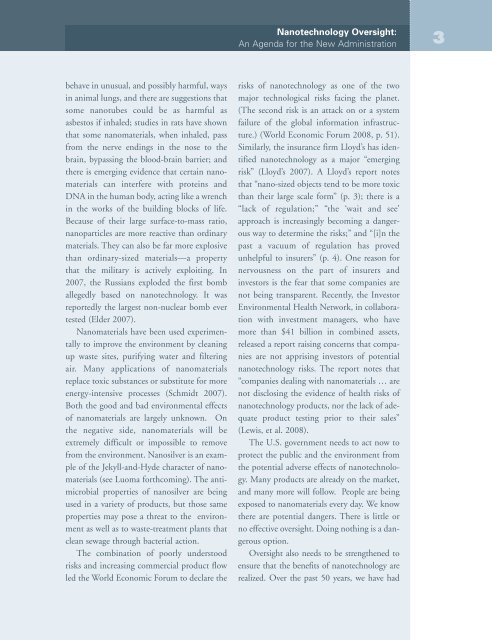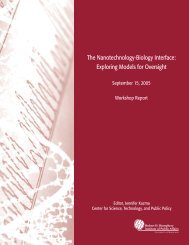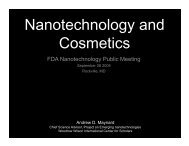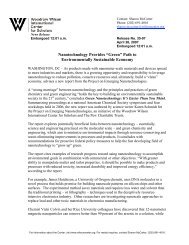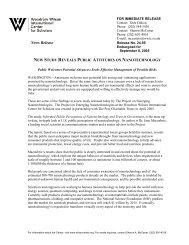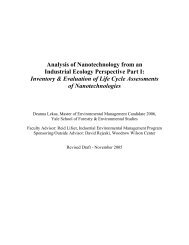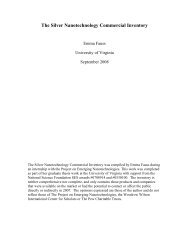nanotechnology oversight - Project on Emerging Nanotechnologies
nanotechnology oversight - Project on Emerging Nanotechnologies
nanotechnology oversight - Project on Emerging Nanotechnologies
Create successful ePaper yourself
Turn your PDF publications into a flip-book with our unique Google optimized e-Paper software.
Nanotechnology Oversight:<br />
An Agenda for the New Administrati<strong>on</strong><br />
3<br />
behave in unusual, and possibly harmful, ways<br />
in animal lungs, and there are suggesti<strong>on</strong>s that<br />
some nanotubes could be as harmful as<br />
asbestos if inhaled; studies in rats have shown<br />
that some nanomaterials, when inhaled, pass<br />
from the nerve endings in the nose to the<br />
brain, bypassing the blood-brain barrier; and<br />
there is emerging evidence that certain nanomaterials<br />
can interfere with proteins and<br />
DNA in the human body, acting like a wrench<br />
in the works of the building blocks of life.<br />
Because of their large surface-to-mass ratio,<br />
nanoparticles are more reactive than ordinary<br />
materials. They can also be far more explosive<br />
than ordinary-sized materials—a property<br />
that the military is actively exploiting. In<br />
2007, the Russians exploded the first bomb<br />
allegedly based <strong>on</strong> <str<strong>on</strong>g>nanotechnology</str<strong>on</strong>g>. It was<br />
reportedly the largest n<strong>on</strong>-nuclear bomb ever<br />
tested (Elder 2007).<br />
Nanomaterials have been used experimentally<br />
to improve the envir<strong>on</strong>ment by cleaning<br />
up waste sites, purifying water and filtering<br />
air. Many applicati<strong>on</strong>s of nanomaterials<br />
replace toxic substances or substitute for more<br />
energy-intensive processes (Schmidt 2007).<br />
Both the good and bad envir<strong>on</strong>mental effects<br />
of nanomaterials are largely unknown. On<br />
the negative side, nanomaterials will be<br />
extremely difficult or impossible to remove<br />
from the envir<strong>on</strong>ment. Nanosilver is an example<br />
of the Jekyll-and-Hyde character of nanomaterials<br />
(see Luoma forthcoming). The antimicrobial<br />
properties of nanosilver are being<br />
used in a variety of products, but those same<br />
properties may pose a threat to the envir<strong>on</strong>ment<br />
as well as to waste-treatment plants that<br />
clean sewage through bacterial acti<strong>on</strong>.<br />
The combinati<strong>on</strong> of poorly understood<br />
risks and increasing commercial product flow<br />
led the World Ec<strong>on</strong>omic Forum to declare the<br />
risks of <str<strong>on</strong>g>nanotechnology</str<strong>on</strong>g> as <strong>on</strong>e of the two<br />
major technological risks facing the planet.<br />
(The sec<strong>on</strong>d risk is an attack <strong>on</strong> or a system<br />
failure of the global informati<strong>on</strong> infrastructure.)<br />
(World Ec<strong>on</strong>omic Forum 2008, p. 51).<br />
Similarly, the insurance firm Lloyd’s has identified<br />
<str<strong>on</strong>g>nanotechnology</str<strong>on</strong>g> as a major “emerging<br />
risk” (Lloyd’s 2007). A Lloyd’s report notes<br />
that “nano-sized objects tend to be more toxic<br />
than their large scale form” (p. 3); there is a<br />
“lack of regulati<strong>on</strong>;” “the ‘wait and see’<br />
approach is increasingly becoming a dangerous<br />
way to determine the risks;” and “[i]n the<br />
past a vacuum of regulati<strong>on</strong> has proved<br />
unhelpful to insurers” (p. 4). One reas<strong>on</strong> for<br />
nervousness <strong>on</strong> the part of insurers and<br />
investors is the fear that some companies are<br />
not being transparent. Recently, the Investor<br />
Envir<strong>on</strong>mental Health Network, in collaborati<strong>on</strong><br />
with investment managers, who have<br />
more than $41 billi<strong>on</strong> in combined assets,<br />
released a report raising c<strong>on</strong>cerns that companies<br />
are not apprising investors of potential<br />
<str<strong>on</strong>g>nanotechnology</str<strong>on</strong>g> risks. The report notes that<br />
“companies dealing with nanomaterials … are<br />
not disclosing the evidence of health risks of<br />
<str<strong>on</strong>g>nanotechnology</str<strong>on</strong>g> products, nor the lack of adequate<br />
product testing prior to their sales”<br />
(Lewis, et al. 2008).<br />
The U.S. government needs to act now to<br />
protect the public and the envir<strong>on</strong>ment from<br />
the potential adverse effects of <str<strong>on</strong>g>nanotechnology</str<strong>on</strong>g>.<br />
Many products are already <strong>on</strong> the market,<br />
and many more will follow. People are being<br />
exposed to nanomaterials every day. We know<br />
there are potential dangers. There is little or<br />
no effective <str<strong>on</strong>g>oversight</str<strong>on</strong>g>. Doing nothing is a dangerous<br />
opti<strong>on</strong>.<br />
Oversight also needs to be strengthened to<br />
ensure that the benefits of <str<strong>on</strong>g>nanotechnology</str<strong>on</strong>g> are<br />
realized. Over the past 50 years, we have had


